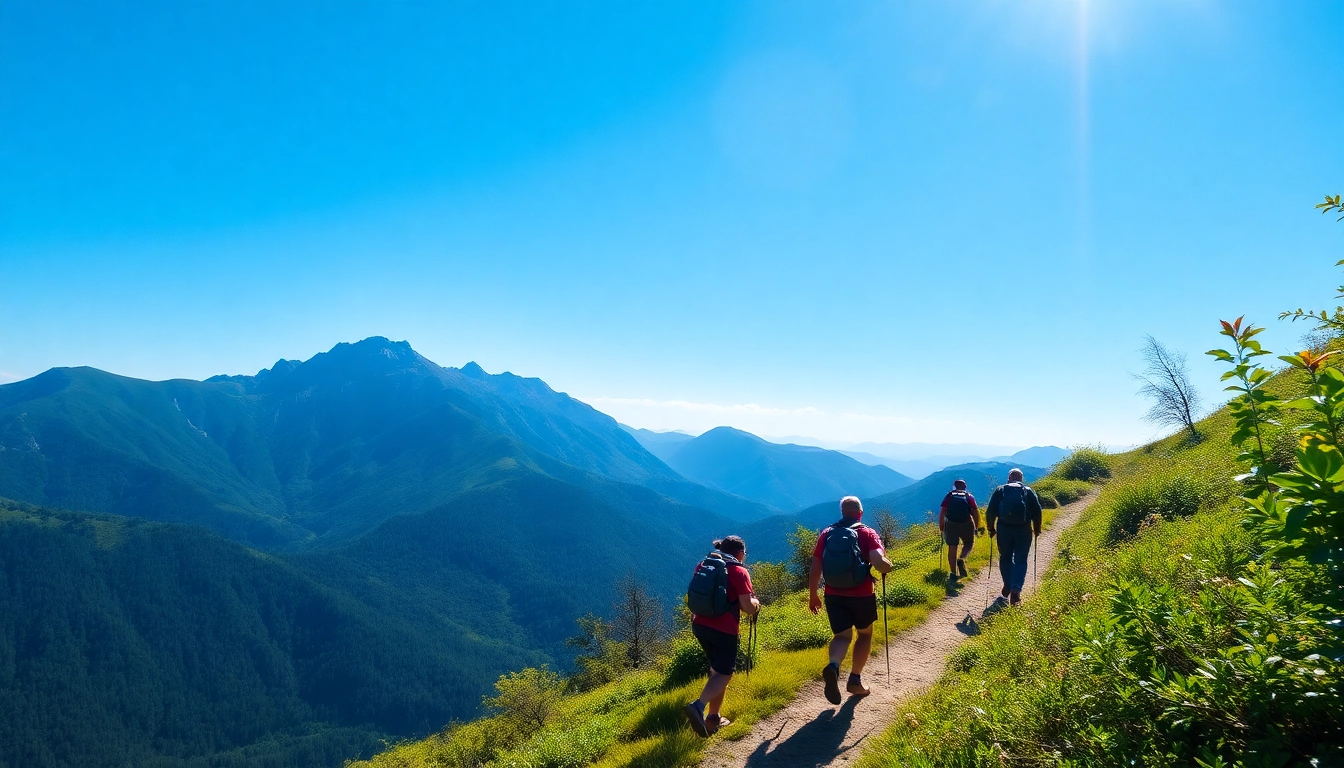Understanding Hiking: Definitions and Differences
What Is Hiking? Key Characteristics and Outdoor Enjoyment
Hiking is a popular outdoor activity that involves long-distance walking along designated trails or footpaths, often set in natural environments such as mountains, forests, and parks. Unlike casual walking, hiking is characterized by its vigorous pace and the purposeful traversal of varied terrains, emphasizing physical endurance and exploration. It provides an immersive experience with nature, offering hikers the opportunity to reconnect with the environment while engaging in a form of exercise that benefits both body and mind.
In the context of Indonesia, and particularly in regions like Lombok, hiking can lead adventurers through breathtaking landscapes, from lush jungle trails to volcanic slopes. To explore more about outdoor activities and hiking in Indonesia, visit hiking and discover guided trails and local tips to enhance your experience.
The appeal of hiking lies not only in physical health benefits but also in the mental clarity it provides. As hikers traverse natural scenery, they often experience stress relief, increased mental alertness, and a sense of achievement. Modern hiking enthusiasts tend to carry essential gear such as hiking boots, backpacks, water bottles, and navigation tools, ensuring safety and comfort during their journey.
Hiking vs Trekking: Main Distinctions and Terrains
While often used interchangeably, hiking and trekking are distinct activities with specific characteristics. Hiking generally refers to walking on trails that are accessible and relatively safe, usually lasting a few hours or a day. It typically involves well-marked routes, maintained pathways, and a focus on leisure and recreation. Hiking can be easily undertaken by beginners and casual outdoor enthusiasts, making it an excellent introduction to outdoor activities.
Trekking, on the other hand, is a more demanding and multi-day adventure that involves traversing remote, rugged, and often challenging terrains. Trekkers carry more gear, including camping supplies, and must plan for prolonged exposure to elements like altitude, weather, and terrain difficulty. An example of trekking in Indonesia would be multi-day expeditions through the Komodo Island or the highlands of Papua, requiring higher endurance and preparation.
The key distinction is the intensity and scope: hiking is suitable for day trips and beginner-level outings, while trekking involves longer, often overnight stays in wilderness conditions. Both activities offer unique benefits and cater to different levels of outdoor experience.
Historical Roots and Evolution of Hiking as a Popular Activity
The origins of hiking trace back centuries, evolving from simple strolls in nature to a structured recreational activity. In Europe during the 18th century, walking excursions grew popular as a leisure activity among the upper classes, often linked to health and social pursuits. Over time, this pastime became democratized, gaining popularity worldwide, especially with the rise of outdoor recreation in the 20th century.
In Indonesia, hiking gained momentum with the development of national parks and protected areas. The volcanic landscapes of Lombok, Mount Rinjani, and other scenic mountains became popular destinations for both locals and tourists seeking adventure and natural beauty. The development of hiking clubs and outdoor tourism has further propelled this activity into mainstream recreation, emphasizing health benefits, eco-tourism, and cultural exploration.
Today, hiking is recognized as a sustainable outdoor activity that promotes environmental awareness and conservation. The evolution from a leisurely walk to a competitive sport and eco-tourism attraction highlights its widespread appeal.
Popular Hiking Destinations in Indonesia
Majestic Mountains and Scenic Trails in Lombok
Indonesia’s diverse topography offers some of the most stunning hiking destinations in Southeast Asia. Lombok, famous for its volcanic landscapes, presents hikers with Mount Rinjani—Indonesia’s second highest volcano—standing at 3,726 meters. This active volcano and the surrounding crater lake, Segara Anak, provide breathtaking views, challenging terrain, and a truly rewarding experience for experienced hikers.
Other scenic trails in Lombok include the Benang Stokel Waterfall hike, which combines lush greenery, waterfalls, and cultural sites, ideal for beginners and family outings. The Tiu Dome Valley offers a less crowded but equally mesmerizing trek through terraced rice paddies and traditional Sasak villages.
Hidden Gems and Lesser-Known Hiking Spots
Beyond the popular peaks, Indonesia harbors numerous hidden hiking gems. For instance, the Mount Tambora in Sumbawa offers a multi-day trek with surreal volcanic landscapes and historical significance, being the site of the world’s largest eruption in 1815.
In Papua, the Lorentz National Park is a UNESCO World Heritage Site hosting trails through pristine rainforests, alpine meadows, and glaciers—ideal for explorers seeking solitude and untouched nature. Lesser-known beaches, waterfalls, and cave systems in Bali, Sumatra, and Kalimantan also present exciting off-the-beaten-path opportunities.
Tips for Choosing the Right Trail for Your Skill Level
Selecting a suitable trail is essential for safety and enjoyment. Beginners should start with well-marked and maintained trails, such as the trails around Mount Rinjani’s base or gentle forest walks. Intermediate hikers can challenge themselves with higher altitudes or longer routes, while advanced hikers may seek multi-day or backcountry expeditions.
Factors to consider include trail difficulty, altitude, weather conditions, and available facilities. Consulting local guides, reading trail reviews, and understanding your physical condition are crucial steps. Always remember to choose trails aligned with your experience and fitness level for a safe and pleasurable adventure.
Preparing for a Safe and Enjoyable Hike
Essential Hiking Gear and Equipment
Proper gear significantly enhances safety and comfort. Core items include sturdy hiking boots suitable for rugged terrains, moisture-wicking clothing, climate-appropriate layers, and a durable backpack. Other essentials encompass navigation tools like maps or GPS devices, first aid kits, sun protection (hats, sunglasses, sunscreen), and sufficient water and high-energy snacks.
Depending on the trail’s difficulty and duration, additional equipment such as trekking poles, headlamps, multi-tools, and emergency shelter may be necessary. Investing in quality gear tailored to tropical climates, like lightweight rain jackets and quick-drying fabrics, ensures preparedness against Indonesia’s unpredictable weather.
Planning Your Route and Safety Precautions
Meticulous planning is vital. Before setting out, research the trail, check weather forecasts, and inform someone about your itinerary. Carrying a fully charged communication device, such as a portable battery pack, can be life-saving.
Safety precautions involve staying on designated paths, avoiding risky shortcuts, and respecting local regulations and cultural sites. For remote areas, hiring local guides familiar with the terrain enhances safety and enriches the experience with cultural insights. Adapting to terrain difficulty, terrain type, and altitude ensures safety throughout your adventure.
Physical Preparation and Mental Readiness
A successful hike depends on physical and mental preparedness. Incorporate cardiovascular exercises, strength training, and flexibility routines into your training plan months before the scheduled hike. Acclimating to altitude changes gradually prevents altitude sickness.
Mentally, cultivating patience, resilience, and adaptability helps in overcoming unforeseen challenges such as fatigue, weather shifts, or navigational uncertainties. Building a positive mindset and maintaining hydration and nutrition are key to sustaining energy and focus during your trek.
Health Benefits and Outdoor Recreation Advantages
Physical Fitness and Cardiovascular Health
Hiking is an excellent cardiovascular workout that promotes heart health, improves endurance, and aids weight management. Engaging multiple muscle groups—legs, core, arms—helps in strengthening muscles and improving overall body tone. Regular hiking sessions can reduce the risk of chronic diseases such as hypertension, diabetes, and obesity.
Mental Well-being and Stress Relief
Beyond physical benefits, hiking significantly contributes to mental health. Immersion in nature reduces cortisol levels, alleviates anxiety, and boosts mood. The rhythmic activity combined with scenic vistas provides meditative qualities, fostering mindfulness and emotional stability.
Moreover, disconnecting from digital devices during hikes encourages presence and mental clarity, helping to combat stress and improve sleep quality.
Environmental Awareness and Sustainable Hiking Practices
Responsible hiking emphasizes environmental conservation. Adopting Leave No Trace principles—disposing of waste properly, minimizing ecological disturbance, and respecting wildlife—is essential. Supporting local communities through eco-friendly tourism and choosing sustainable trail options enhances conservation efforts.
Educated hikers contribute not only to their health but also to preserving Indonesia’s pristine landscapes for future generations.
Getting Started: Tips for Beginners in Hiking
Basic Skills and Beginner-Friendly Trails
New hikers should focus on developing fundamental skills such as proper walking techniques, navigation, and using basic gear. Starting with easy, well-marked trails like the Selong Hill in Lombok or Bali’s Campuhan Ridge Walk helps build confidence.
Participating in guided hikes or outdoor courses can accelerate skill acquisition and safety awareness. Gradually increasing difficulty as proficiency grows ensures sustainable progression.
Common Challenges and How to Overcome Them
Challenges include fatigue, dehydration, navigational errors, and weather obstacles. Preparing by carrying adequate water, applying sunscreen, and dressing appropriately minimizes risks. Learning how to read maps, use GPS, and recognize trail markers is vital.
Facing fears such as altitude sickness or unfamiliar terrain can be addressed through proper training, pacing, and seeking guidance from experienced hikers.
Building a Hiking Routine and Community Engagement
Establishing a regular hiking schedule enhances physical fitness and fosters community connections. Joining local hiking clubs, online forums, or social media groups creates support networks, sharing tips, experiences, and organizing group treks.
With consistency, hiking transforms from a sporadic activity into a meaningful lifestyle choice that promotes health, environmental awareness, and cultural exchange.

